Masters Thesis
Aspect Oriented Programming
Based on .Net Interception
Revised: 6/12/2010

Advisor Fawcett and Candidate Krishnan-Chittur
Defense
Ramaswamy successfully defended this work on April 29, 2005, before his committee: Drs. Kamal Jabbour, Can Isik (chair),
Daniel Pease, and Jim Fawcett (advisor), all from the department of Electrical Engineering and Computer Science.
Thesis Documents and Code
Defense Presentation
Thesis Document
Aspect Oriented Code
Summary
-
Aspect Oriented Programming (AOP) attempts to separate application code from the services on which it depends. Usually the services
provide system level support for transactions, security, threading, messaging, and others that are needed by the application
but not central to its mission.
-
Traditional programming provides these services through libraries and modules developed as part of the application's code. AOP
provides these services using intercepted calls to specific functions. The interception processing provides the services in a way
that is nearly transparent to the using application, leading to simpler, cleaner code. Often interception is defined using code
attributes in a declarative style, so instead of calls to library functions to support thread synchronization, for example, we
simply decorate the method with a synchronizing attribute.
-
In this work, Ramaswamy investigated AOP, using .Net interception, to provide method synchronization, debugging, code coverage,
temporal profiling, and message prioritization.
He has shown that these services, some of which would be very hard to provide without interception, can be implemented with the .Net interception
mechanism, and that the application part of the code is significantly simpler and easier to understand.

Defense Committee with Candidate

